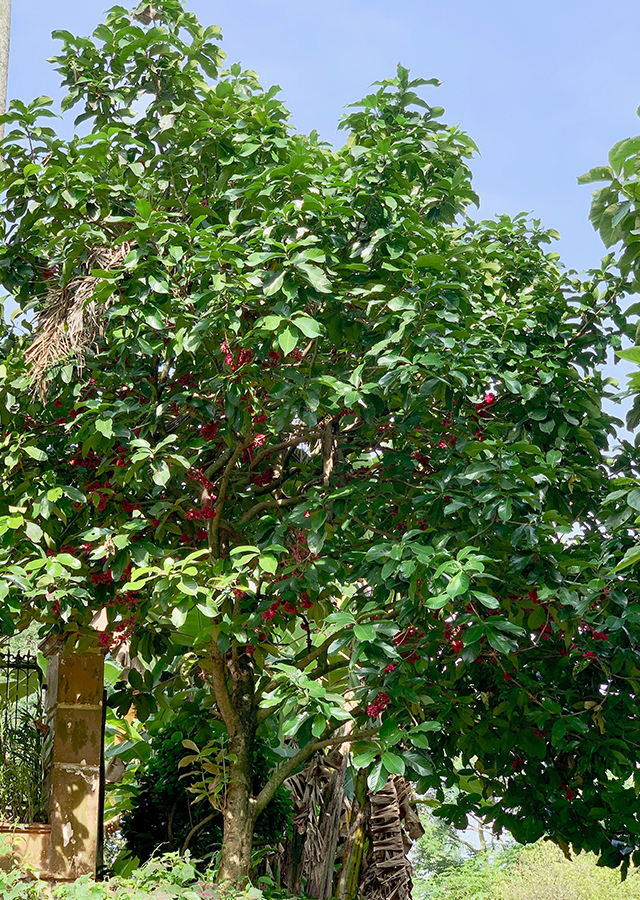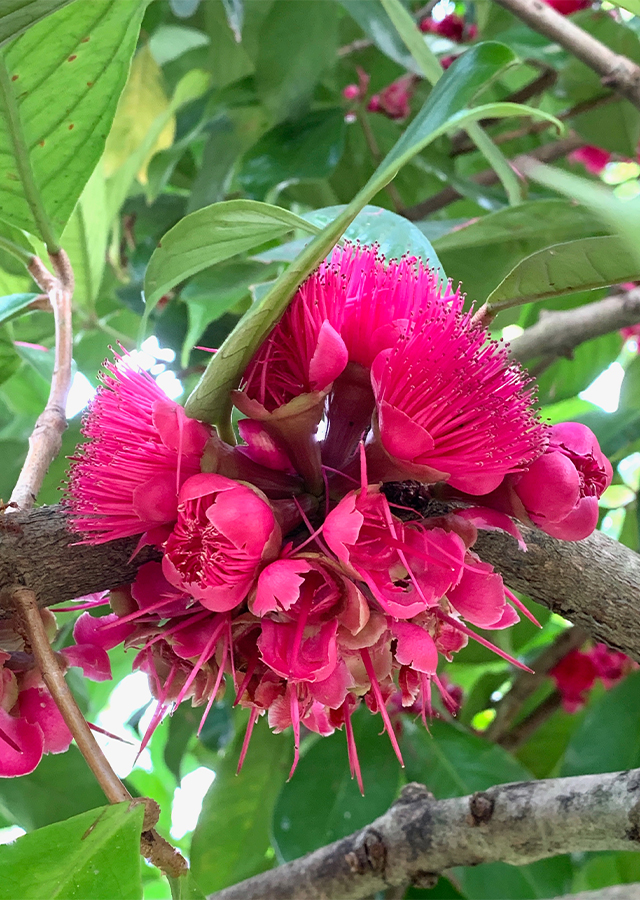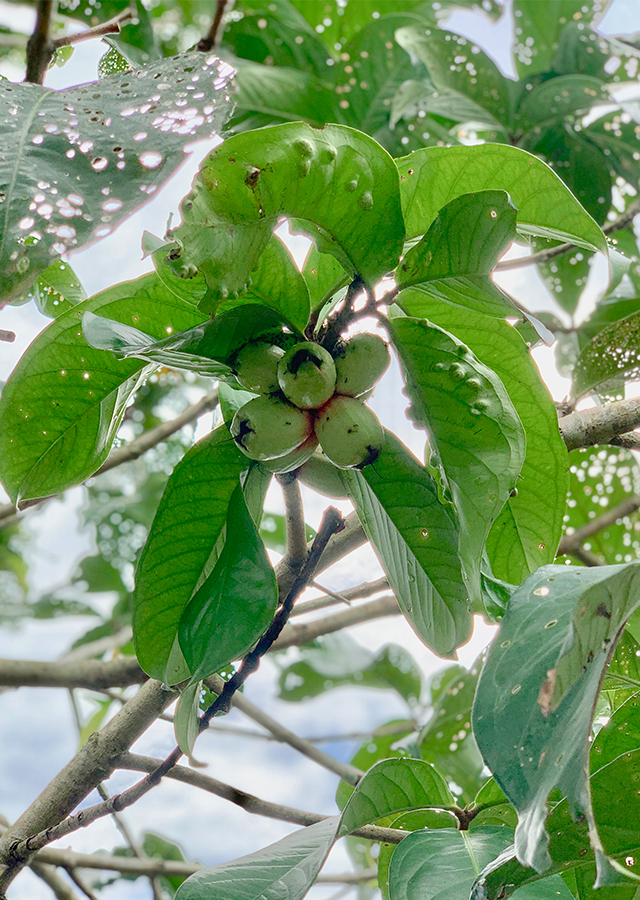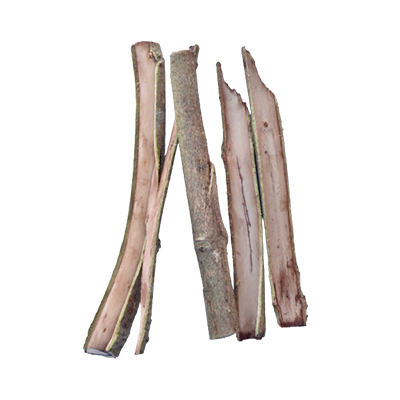Malay Apple
Syzygium malaccense (L.) Merr. & L.M.Perry
Myrtaceae
Location in our garden
Orchard



Synonym
Caryophyllus malaccensis (L.) Stokes
Eugenia domestica Baill.
Eugenia macrophylla Lam.
Habitus
Trees. An evergreen perennial tree, growing to 15–30 m high with straight trunk
Part Used
Leaves
Bark
Fruit
Roots
Growing Requirements
Full Sunshine
High Rainfall
Habitat
Terrestrial
Overview
Malay apples are native to Vanuatu from Southeast Asia, but their exact origin is unknown, perhaps in the Peninsular Malaysia, Java and Sumatra lowland rainforests. In many countries across the tropics, especially in Indo-Malaysia, Southeast Asia, East Africa, Central and South America, Melanesia, Polynesia and Micronesia, it is now cultivated and naturalized.
Vernacular Names
Jambu bool (Indonesia), Tual (Philippines), Chom-Phu-Daeng (Thai), Maree Futo Momo (Japanese), Jambu De Malacca (Portuguese), Djamboe Bol (Dutch), Manzana de agua (Spanish), Jamboissier rouge (French), Grosser Rosenapfel (German).
Agroecology
It occurs up to an altitude of 1,000 m in its native range in the lowland tropical rainforests. In areas with an average annual temperature of 24-30 ° C and with evenly distributed rainfall and an average annual rainfall above 1,500 mm, it is highly frost intolerant and grows best. It prefers a fertile, well-drained soil and a full sun location. Refers to a pH in the 5.5 - 6.5 range, tolerating 5 - 8.
Morphology
- Barks - pale-brown, rough, flaky or fissured.
- Leaves - opposite, petiolate (10 mm long),elliptic-oblong to broadly oblong-lanceolate, 5–30 cm by 7.5–15 cm, the young leaves are pinkish.
- Flowers - showy, red, 2.5 cm across, bisexual; calyx turbinate, 1.2–1.8 cm long with 4 pale yellow, rounded lobes; corolla with 4, redor pink rounded petals.
- Fruits - 4-7.5 cm long, shiny, waxy, white, greenish white, dark pink, red, purple-red or white red striped apple, large, fleshy, ovoid, pear-shaped, dumb-bell-shaped or oblong berry.
Cultivation
- Propagated by seeds, cuttings and air layering.
- The seeds germinate well and beneath their parent tree, many can typically be found sprouting.
- The tree thrives in cultivation in volcanic soil with suffi-cient year-round rain in the humid and subhumid tropics.
Chemical Constituents
Phenolic acid (coumaric and benzoat acid), alkaloids, saponins, tannins, flavonoids, quinones, anthocyanin, procyanidin, quercetin, carotenoid, steroids, thiamine, riibovlavin, niacin, and vitamin C.
Traditional Medicinal Uses
Medicinal Uses
- As dietary fibers and as antioxidant capability of its edible parts, the fruit was highlighted.
- In vitro studies have demonstrated antiproliferative effects of fruit extracts against breast and liver tumor cell lines as a possible functional property. Malay apple bioactive compounds stimulate research into potential associations with in vivo functional properties, primarily with regard to anticancer activity.
- Antibiotic activity has been demonstrated by seeded fruits, seeds, bark and leaves and has some effect on blood pressure and respiration.
Traditional Uses
- A decoction of the bark is used for thrush care in the Molucca, or Spice Islands.
- A powder of dried leaves is spread on a broken tongue by Malayans.
- Root preparation is a treatment for scratching. As a diuretic, the root functions and is given to relieve edema. Useful against dysentery, the root bark also acts as an emmenagogue and abortifacient.
- A febrifuge is a decoction of the berries, leaves or seeds taken by Cambodians. As a skin lotion, the juice from crushed leaves is applied and added to the baths.
- In Brazil, as treatments for constipation, diabetes, cough, pulmonary catarrh, headache and other illnesses, different parts of the plant are used.
- In Samoa an infusion of the crushed leaves or scraped barkis very commonly taken as a potion, the leaves are chewedand the juice swallowed, or the leaf juice is dripped intothe mouth of an infant to treat mouth infections.
- In Tongaan extract of bark scrapings is commonly administeredto treat throat infections and stomachache, and is an in-gredient in various remedies for a complex of abdominalailments known as kahi.
- In the Cook Islandsa solution of the crushed leaves, or to a lesser extent thegrated bark, is widely used to treat thrush, and a solutionof the grated bark is sometimes administered as an emetic.
- The root bark is used to treatdysentery and serves as an emmenagogue (promoting men-strual function) and abortifacient.
- Cambodians reportedlytake a decoction of the fruit, leaves, or seeds as a febrifuge(against fever).
Part Used
Reference Sources
- Batista, A.G., Silva-Maia, J.K., and Junior, M.R.M. (2019). Bioactive Compounds of Red-Jambo Fruit (Syzygium malaccense (L.) Merr. & L.M. Perry. https://link.springer.com/referenceworkentry/10.1007%2F978-3-030-06120-3_27-1. 02-12-2020.
- CABI. (2015). Invasive Species Compendium. Syzygium malaccense. Malay apple. https://www.cabi.org/isc/datasheet/52448 02-12-2020
- Morton, J. (1987). Fruits of warm climates, Miami, FL. 33189. Winterville, N.C. 28590. Page 378-381.
- Lim, T.K. (2012). Edible Medicinal and Non-Medicinal Plants. Vol 3, Fruits. Springer. New York Page 769
- Whistler W.A., and C.R. Elevitch. 2006. Syzygium malaccense (Malay Apple). Species Profiles for Pacific Island Agroforestry (www.traditionaltree.org)



